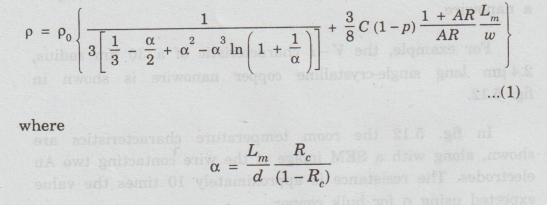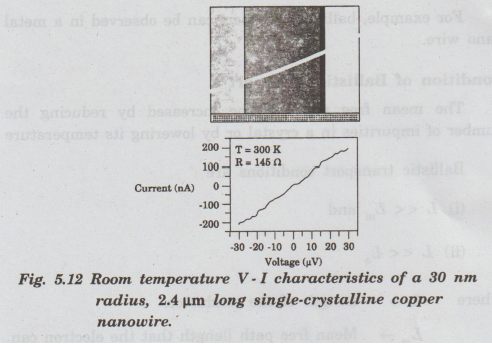Physics for Electrical Engineering: Unit V: Nano Devices
Conductivity of metallic nanowires
Nano Devices
Let us study what happens when wire length L becomes extremely small relative to the mean free path and the influence of wire cross-section size on conductivity of metallic nanowires.
CONDUCTIVITY OF METALLIC NANOWIRES
Let
us study what happens when wire length L becomes extremely small relative to
the mean free path and the influence of wire cross-section size on conductivity
of metallic nanowires.
Consider
a circular cross-section wire which has radius a and length L. Assume that L is
very large compared to the mean free path.
For
example, assuming a copper (σ = 5.9 × 107 S/m) wire having radius ɑ
= 10 mm, R = 5.395 × 10-5 ohms/m. However if ɑ = 10 μ m, R = 53.95
ohms/m amounting to 1 ohm in only 1.85 cm. If ɑ = 10 nm, the resistance is
huge, R = 5.395 × 107ohms/m.
It
is important to note that for wires having radius values in the order of the
mean free path or less the conductivity value is changed from the case of a
bulk material.
For
example, copper has a mean free path of approximately 40 nm, and in this range,
radius-dependent effects are usually manifest.
In
fact, we may consider that radius dependent effects may occur even when the
radius is approximately double this value, in the order of 80 - 100 nm.
In
the 1 - 20 nm radius range, the conductivity of the wire certainly will differ
appreciably from the bulk value, and generally the conductivity significantly
decreases as a is reduced.
This
is due to several effects, such as scattering from the wire's surface, from
grain boundaries defects etc.,
Thus,
we can use the bulk value of conductivity for many good conductors when the
radius value is above approximately a = 80 - 100 nm.
Below
this point, down to radius values of perhaps 5-10 nm (but above metallic
quantum wire dimensions), we may expect to need to use a size dependent value
of conductivity, perhaps based on measurement.
A
relatively simple approximate formula for the resistivity (p) of rectangular
cross-section wires is

where
P0 - bulk resistivity
w
- wire width
AR
- Physics for Electrical Engineering
AR
aspect ratio (wire height divided by wire width),
d
- average grain size (for relatively narrow wires this can be taken as the wire
width),
p
- specularity parameter (relating to reflection from the wire surface),
Re
- grain boundary reflectivity coefficient
C
- a constant (taken to be 1.2 in this model).
The
first term is related to grain-boundary scattering and the second term
wire-surface scattering.
Both
p and Rc can take values between 0 and 1, and typical values
determined by fitting equation (1) to experimental results are p = 0.3-0.5 and
Rc = 0.2 - 0.3.
For
example, using p = 0.50 and Re = 0.27 we have σ = 1.22 × 107
S/m for a 10 × 10 nm2 copper wire (down from 5.9 × 107 S/m
for the bulk value).
This
model may work down to wire cross-sectional dimensions in the order of 5-10
nanometres.
However,
as complicated as surface and grain-boundary scattering are other factors also
determine the conductivity of a nanowire.
For
example, the V-I characteristic of a 30 nm radius, 2.4 μm long
single-crystalline copper nanowire is shown in fig. 5.12.
In
fig. 5.12 the room temperature characteristics are shown, along with a SEM
image of the wire contacting two Au electrodes. The resistance is approximately
10 times the value expected using σ for bulk copper.

Physics for Electrical Engineering: Unit V: Nano Devices : Tag: : Nano Devices - Conductivity of metallic nanowires
Related Topics
Related Subjects
Physics for Electrical Engineering
PH3202 2nd Semester 2021 Regulation | 2nd Semester EEE Dept 2021 Regulation
